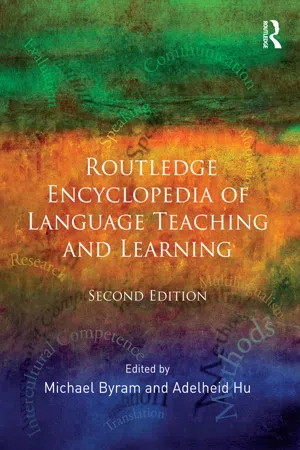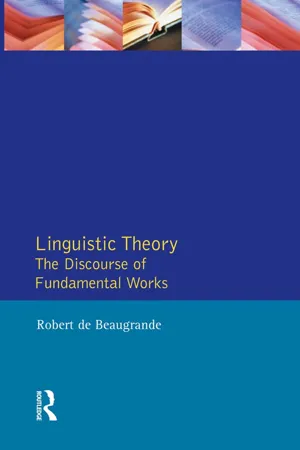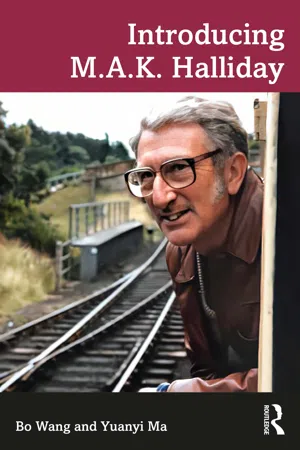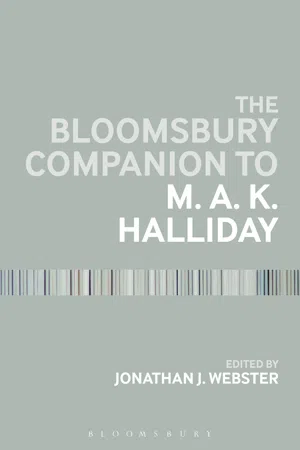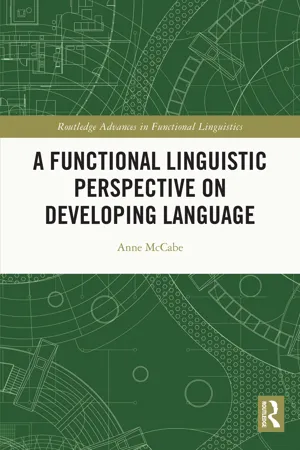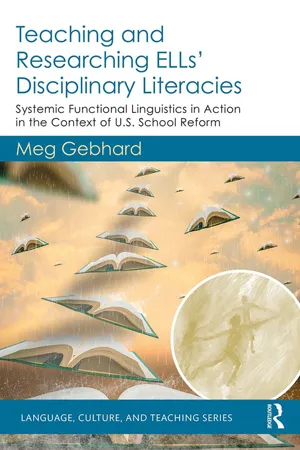Languages & Linguistics
Michael Halliday
Michael Halliday was a prominent linguist known for his work in systemic functional linguistics. He developed a theory of language known as systemic functional grammar, which emphasizes the functional aspects of language and how it is used to express meaning in different social contexts. Halliday's work has had a significant impact on the fields of linguistics, education, and language studies.
Written by Perlego with AI-assistance
Related key terms
Related key terms
1 of 4
Related key terms
1 of 3
9 Key excerpts on "Michael Halliday"
- Michael Byram, Adelheid Hu(Authors)
- 2013(Publication Date)
- Routledge(Publisher)
H
DOI: 10.4324/9780203101513-13Halliday, Michael Alexander Kirkwood
b. 1925, Leeds, UKThe founder of systemic-functional linguistics, Michael Halliday pioneered the analysis of language in its social context. He convincingly re-estabilished the centrality of meaning in understanding how language functions after the domination of linguistic research by Chomsky's generative grammar model.After studying Chinese language and literature at London University, he studied linguistics in China and completed his doctorate at Cambridge University. He taught at Universities in the UK and the USA before being appointed foundation Professor of Linguistics at Sydney University, Australia, (1973–87). His huge publication output of over 170 books and articles and his many keynote addresses at conferences of linguists and language teachers brought him acclaim as a leading international scholar in the linguistic sciences.Halliday's broad range of research interests is foreshadowed in the topics of his first three articles: ‘Grammatical categories in Modern Chinese’ (1956); ‘The linguistic basis of a mechanical thesaurus’ (1956); ‘Some aspects of systematic description and comparison in grammatical analysis’ (1957). The Chinese language was to inspire numerous articles including ‘Analysis of scientific texts in English and Chinese’ (1993). The ‘mechanical thesaurus’ topic evolved into machine translation and the principles of translation in ‘Towards a theory of good translation’ (1998). The analysis of language from a socio-cultural perspective produced his systemic-functional model. Other significant publication topics revealing the breadth of his expertise were to be intonation in English, child language development, the linguistic study of literary texts, scientific English, and the construction of knowledge founded on language as a system for making meaning.Systemic-functional linguistics is derived from the work of Malinowski, Firth (Halliday's teacher), Hjelmslev and Whorf. For Halliday, language is not only part- eBook - ePub
Linguistic Theory
The Discourse of Fundamental Works
- Robert-Alain De Beaugrande(Author)
- 2014(Publication Date)
- Routledge(Publisher)
Chapter 9 M.A.K. Halliday 1 9.1 Michael Alexander Kirkwood Halliday was a pupil of Firth's, and, with greater elaboration, has pursued similar precepts, above all that ‘linguistics’ should ‘deal with meaning’ ‘at all levels of analysis’ and should study ‘texts’ ‘in contexts of situation’ (cf. 8.46f vs. 9.8, 22f, 38, 49, 107). Halliday finds ‘the question “what is language?”’ unduly ‘diffuse’ and ‘disingenuous’, because ‘no one account of language will be appropriate for all purposes’ (IF xxix; EF 9) (cf. 12.22). ‘A theory being a means of action’, we must consider what ‘action’ we ‘want to take’ ‘involving’ ‘language’, so we know what is ‘relevant’ and ‘interesting’ for ‘the investigation or the task at hand’ – ‘the nature and functions of language’, its ‘formal properties’, its ‘role’ ‘in the community and the individual’, its ‘relation’ to ‘culture’, and so on (EF 9; IF xixf) (cf. 9.111 ; 10.6 ; 12.58). We may inquire ‘what all languages have in common’ or how they ‘differ’, and how they ‘vary according to user’ and ‘function’ or ‘evolve through time’; or ‘how a child develops language, and how language may have evolved in human species’. Or, we may explore ‘the quality of texts’ such as ‘written and spoken’ or ‘literary and poetic’ (IF xxx). Or, we may seek ways to ‘help’ people ‘learning their mother tongue’ or a ‘foreign language’, or ‘training translators and interpreters’, or composing ‘reference works (dictionaries, grammars)’ or ‘computer software’ to ‘produce and understand’ ‘text’ and ‘speech’ - eBook - ePub
- Bo Wang, Yuanyi Ma(Authors)
- 2022(Publication Date)
- Routledge(Publisher)
- Matthiessen, Wang and Ma (2019a, 2020); Matthiessen et al. (2022: Chapters 1–3)
Connection with other functional approaches to language
Halliday’s theory grew out of the tradition of the functional theories of language. Like Firth, Halliday (e.g. 1985b) always emphasized the links between his works and those by other scholars, including both his predecessors and contemporaries, such as Hjelmslev, the Prague School (see e.g. Halliday 1974 ; Davidse 1986 ) and Malinowski (e.g. Hasan 1985a ) in Europe as well as Sapir, Boas, and Whorf in the United States; of course Firth’s (1957 , 1968a) system–structure theory is also included in this list as an important source of insights; see Butt (2001 , 2019) for relationship between Firth’s and Halliday’s theories. Both Halliday and Firth regarded linguistics as a collaborative effort; unlike Chomsky (e.g. 1957, 1965), who provided a model of creating one’s own ethos by not acknowledging the people he owed to such as Harris and Hockett (cf. Matthiessen, Wang & Ma 2020). On all accounts, Halliday’s theory is functional, conceiving language as resource and approaching language ecologically (see entry on language as resource).However, Halliday’s theory is different from other functional theories in that Halliday (e.g. 1966a, 2013) chooses to highlight the paradigmatic organization of language among the paradigmatic and syntagmatic axes. Referred to as “the axial rethink” by Christian Matthiessen (Matthiessen 2015b; Matthiessen et al. 2018), Halliday’s approach starts from system (paradigmatic patterns) rather than from structure (syntagmatic patterns), thus providing us a unique view on language (see entry on axis).Meanwhile, Halliday’s theory shares certain features with the formal theories of language by maintaining the connection with the syntagmatic structure by way of the realization statements and the box diagrams used in the analysis. In this sense, SFL is both functional and formal. It is perhaps for this reason that Halliday’s theory is regarded as a “taboo” according to Mary Douglas’s (e.g. 1984) explanation (Matthiessen 2015b; Matthiessen et al. 2022: Chapter 4 - eBook - ePub
- John Flowerdew(Author)
- 2012(Publication Date)
- Routledge(Publisher)
Another criticism is the lack of an empirical basis for the claim for three contextual parameters and three corresponding metafunctions. Other linguists have come up with other functions. Jakobson (1960), for example, has six contextual parameters and corresponding functions. Related to this is the more general critique that SFL does not devote enough attention to analysing context (contrast this with more ethnographic or sociocognitive approaches), preferring to focus more on the lexicogrammar (van Dijk, 2008). On the other hand, proponents of SFL would argue that it is the only school with a robust model to link the text and context systematically. It is no good talking about context if you cannot show how it is systematically construed or expressed by the lexicogrammar.Finally, even if the tripartite divisions are accepted, it may be difficult to decide which features of the lexicogrammar correspond to which metafunction and contextual parameter. In spite of these possible criticisms, as will be emphasised in the next section, Halliday’s framework offers great potential for application to pedagogy.2.14 APPLICATION TO PEDAGOGY
We mentioned in the introduction to this chapter that Halliday has always been concerned with ‘applied’ issues. He refers to his model as appliable linguistics and the research centre set up in his name in 2005 at City University of Hong Kong is called the Halliday Centre for Intelligent Applications of Language Studies. As well as coauthoring The Linguistic Sciences and Language Teaching , Halliday was director of two influential curriculum development projects in the UK in the 1960s and early 1970s. Both of these projects (Breakthrough to Literacy at primary level and Language in Use For Secondary Schools ) were very influential in reforming the teaching of English in the British school system. Fundamental to these projects was the concept of register, as set out in The Lingustic Sciences and Language Teaching, and the need for the child ‘to be taught the varieties of the language appropriate to different situations: the range and use of its registers and restricted languages’ (Halliday et al. , 1964: 241). Halliday’s social commitment comes through in these projects, as it does in the following quotation from The Linguistic Sciences and Language Teaching - eBook - ePub
- Jonathan J. Webster, Jonathan J. Webster(Authors)
- 2015(Publication Date)
- Bloomsbury Academic(Publisher)
In Memoriam , will be examined, in order to show what it means to make an argument about the meaning of these texts from the perspective of SFL. In this final section I will be evaluating Halliday’s arguments against his own claims about the task for ‘a linguistics of style’, which is ‘to demonstrate that the meaning of a text . . . is a great deal more than the manifest propositional content’ ([1987] 2002: 149).2 Influences on Halliday’s IdeasAll of the influences on Halliday as linguist have influenced his account of the language of literature, by virtue of the fact that he draws on his general linguistic theory as the point of departure for the study and analysis of literary text. Malinowski and Hjelmslev, Firth and Whorf, who are so consistently present in his accounts of his general linguistic theory, are also part of the picture when we explore Halliday’s contribution to stylistics. Below I discuss the relation of context of situation and context of culture to Halliday’s stylistics; these are terms from Malinowski (1923), elaborated by Firth (e.g. 1957a). Firth in particular is an important influence on Halliday’s general linguistic theory (e.g. Butt, 2001 – and see the references to Firth in Halliday’s early papers on grammar, in Halliday, 2002a). In his analysis of literary texts, Halliday makes particular reference to Firth’s [1951] 1957 paper, ‘Modes of meaning’; here Firth argues that ‘the main concern of descriptive linguistics is to make statements of meaning’, and that ‘the suggested procedure for dealing with meaning is its dispersion into modes, rather like the dispersion of light of mixed wave-lengths into a spectrum’ (Firth, [1951] 1957: 190–2). Halliday uses this notion of Firth’s in his discussion of Golding (e.g. ‘the syntax is effective as a “mode of meaning”’ (Halliday, [1971] 2002: 120)); of Priestley (e.g. ‘It is a general assumption of structuralism that the meanings of a work of literature are dispersed throughout the text not just at different places in the syntagm but also, and more significantly, at different levels within the code. This dispersal into what Firth called “modes of meaning” . . . is typically an unconscious feature of the writing process’ [1982] 2002: 129–30); and of Tennyson ([1987] 2002: 150). The idea that all strata are meaning-making is relevant also to the discussion of the idea of ‘deautomatization’ of grammar that is central to Halliday’s account of the language of literary text. The idea that analysis incorporates processes of contextualization is also a Firthian legacy in Halliday’s stylistics (e.g. [1987] 2002: 150). - Anne McCabe(Author)
- 2021(Publication Date)
- Routledge(Publisher)
1 Developing LanguageA Functional Linguistic Perspective
“Learning to mean is a process of creation.” (Halliday, 2004a[1978]: 138)The immense attraction of understanding language development—that is, getting at the heart of how we learn language to effectively interact across a wide variety of contexts during our lifespan—is widespread. Parents eagerly latch on to their babies’ first words; teachers of all subjects spend classroom hours explaining terms which they hope students will then use effectively in assignments and exams; and people of all ages and from all walks of life invest substantial time, effort, and money into learning to communicate with others through additional languages. At the same time, perhaps because of the ubiquitous nature of language, we sometimes lose sight of the extraordinary opportunities it provides us for expression, cognition, and interaction throughout our lifetimes.The purpose of this book is to explicate language development from a functional perspective, Systemic Functional Linguistics (SFL), through its theory and accompanying research on how individuals develop their language abilities for meaningful interaction. Each chapter lays out the milieu in which the theory was developed, hand-in-hand with studies of how people develop language over time. SFL was conceived precisely with language development in mind, initially in the context of foreign language teaching; SFL’s founder and major architect, Michael Halliday, began developing the theoretical descriptions of first Chinese and then English when he was teaching Chinese to English speakers and English to Chinese speakers. He continued building on the descriptions through his work with mother-tongue English education in the United Kingdom, and through tracing the language development of his own son from an early age. The following three main sites of language development are included in this book: language development in infancy and early childhood, language development through school, and the development of additional language(s) once a first language has been learned. Along the way, other theoretical and research perspectives, often critical of SFL, are included to further illuminate language development from this functional perspective. These three sites of language development have had their impact on SFL theory, and their repercussions are highlighted. In the final chapter, both the criticisms of SFL theory as it has been applied to language development, and the repercussions that the three areas of language development have had on the theory, are considered in order to prompt suggestions for areas of future research and theory-building for tracing and promoting language development from an SFL perspective.- eBook - ePub
On the Subject of English
The Linguistics of Language Use and Learning
- Henry Widdowson(Author)
- 2019(Publication Date)
- De Gruyter Mouton(Publisher)
Halliday 1994 : xxii). It is thus both systemic and functional and the claim seems to be that in accounting for the meaning potential of clauses as abstract systems it provides the means at the same time for describing its functional realization in the production of actual texts. I have argued that Firth is able to bring extra and intra-linguistic into the same integrated system by invoking the unifying concept of context. Halliday does the same by invoking the concept of function. But just as the term “context” can mean two very different things, so can the term “function”. Halliday’s grammar is functional in the sense that its categories reflect the social functions that the language has evolved to serve. They are the semantic encodings of past pragmatic processes and represent the potential that has been generalized from former realizations, and as such can be seen as a closer approximation to experienced language than the categories of a formalist grammar. But in the actual use of language, this potential is realized anew in different pragmatic ways under the influence of various language-external contextual factors. Though what people mean by what they say must to some degree be constrained by the semantics of their language, it cannot be determined by it. The pragmatic functions of language use cannot be equated with the semantic functions in a systemic grammar.That would seem to be obvious enough. And yet it is not uncommonly assumed that these functions can be equated. A good deal of critical discourse analysis, for example, seems to proceed on this assumption. Critical discourse analysts like Fairclough, for example, explicitly state that they take their linguistic bearings from Halliday, and so, unknowingly perhaps, follow Firthian tradition. They take Halliday’s theory of language as particularly well-suited to their enquiry on the grounds that it “stresses its multifunctionality, which sees any text as simultaneously enacting what Halliday calls the ‘ideational’,’interpersonal’ and ‘textual’ functions of language” (Fairclough 1995 : 131). But these are external pragmatic functions: the internal semantic functions that encode them in the grammar are formalized as systems of transitivity, mood and theme. But Fairclough fuses the two and takes the grammar as providing descriptive categories that are functional and textual as well, and carries out his analysis by applying them. In consequence, interpretation is derived from an analysis of texts in dissociation from extra-linguistic contextual considerations as if the texts were indeed a direct projection of semantic encodings (for further discussion see Widdowson 2004 - eBook - ePub
Teaching and Researching ELLs' Disciplinary Literacies
Systemic Functional Linguistics in Action in the Context of U.S. School Reform
- Meg Gebhard(Author)
- 2019(Publication Date)
- Routledge(Publisher)
Future chapters, especially Chapter Nine, illustrate how teachers working in urban schools with multilingual learners have developed the ability to use SFL pedagogical tools to design, implement, and reflect on student learning as they work toward this goal while also trying to negotiate the demands of current school reforms. (Chapters Six and Seven detail these reforms, including English-only mandates, the passage of No Child Left Behind legislation, the adoption of the Common Core State Standards, the Next Generation Science Standards, and WIDA standards.) However, before describing how teachers have used SFL concepts in their classrooms, it is important to first get a sense of what these concepts are. Therefore, before showing a classroom discourse example that illustrates a social semiotic perspective of grammar, the following sections provide a more in-depth description of Halliday’s grammar, and how it is organized around three meaning-making functions. The concepts introduced here will be further explained in subsequent chapters, which also offer illustrations of how teachers have used SFL in their classrooms to support their students’ disciplinary literacy development in critical ways. 3 Halliday's Conception of Text/Context Dynamics and the Functions of Language Halliday explains how language and other meaning-making systems accomplish the remarkable feat of simultaneously constructing ideas and experiences, negotiating social roles and shifting identities, and managing the flow of discourse in different contexts. For example, local classroom contexts are constructed by the oral, written, and multimodal/multilinguistic texts teachers and students produce and interpret in schools - eBook - ePub
Fathoming Translation as Discursive Experience
Theorization and Application
- Chunshen Zhu(Author)
- 2021(Publication Date)
- Routledge(Publisher)
By taking structuralist semiotics into the domain of social semiotics, SFL characterizes the confluence of linguistic features and human factors in meaning making and observes how potential meaning is channelled into a flow of information for actualization by human receivers. From Halliday (1973, 1978, 1985) we understand that a linguistic system consists of three principal components that can be roughly glossed as follows:- Semantic system: cognitive basis for meaning generation;
- Lexicogrammatical system: wording that facilitates meaning generation;
- Phonological/graphological system: substance that bears the meaning potential.
Under the semantic system, there are three metafunctions fundamental to SFL’s functional perspective on the nature of language, as pointed out by Halliday (1978: 48): ‘language is in fact structured along these three dimensions’:- Ideational function: concerning conceptual and logical content that embodies the language user’s understanding of the world and her relationship with that world, with transitivity processes carrying the logical mechanism of meaning potential.
- Interpersonal function: concerning mood, modality, person and intonational components of the syntactic form, which express the language user’s attitudes and which indicate her position and role in her communication with other users, a function that is ‘both interactional and personal’ (Halliday 1973: 107).
- Textual function: concerning formation that enables the performance of the other two functions, relating the text to the context (the situation and the preceding texts) as well as giving it an independent and unique textuality. As the ‘enabling function’, it is distinct from the other two in that ‘language can effectively express ideational and interpersonal meanings only because it can create text’ (Halliday 1978: 130).
Creation of a text can be primarily triggered by a transactional purpose of conveying ideational information about the world, or can be occasioned chiefly by an interactional need to establish or maintain an interpersonal (social) relationship. In translation, the source text presents itself for interpretation in all its three systems – semantic, lexicogrammatical, and phonological/graphological, but the decision-making process in writing a target text appears more successive and transactional. That is, in interpreting the source text, which is already in existence, the translator is able to examine it in its ideational, interpersonal, and textual functions simultaneously, whereas in creating a target text, she may have to switch attention between the functions: In assessing a text for its appropriateness and relevance in the receiving culture, the translator’s attention is mainly on its ideational content; during the translation, the translator places herself in an interpersonal situation, constantly envisaging an audience and envisioning their responses based on her understanding of humanity in general and the targeted readership in particular. Finally, the translator’s attention is focused on the textual resources provided by the lexicogrammatical and phonological/graphological systems of the target language to physically create a target text in light of the ideational assessment and interpersonal consideration.
Index pages curate the most relevant extracts from our library of academic textbooks. They’ve been created using an in-house natural language model (NLM), each adding context and meaning to key research topics.
Explore more topic indexes
Explore more topic indexes
1 of 6
Explore more topic indexes
1 of 4
